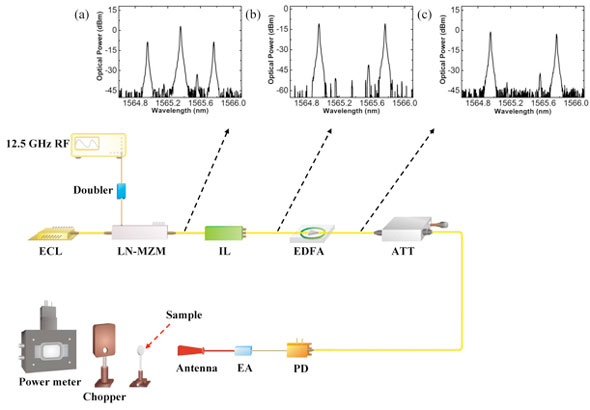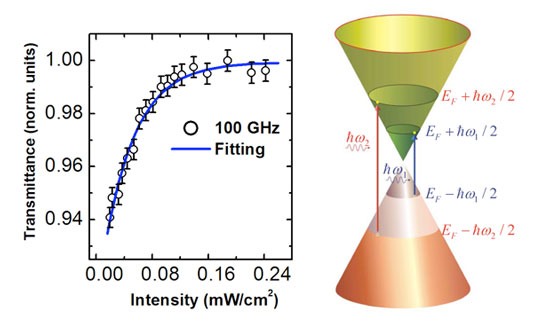| Posted: Oct 02, 2012 | |
The rise of graphene in microwave photonics |
|
| (Nanowerk Spotlight) In 2010, a Nanowerk Spotlight highlighted the importance of graphene in ultra-fast photonics and predicted that the unique energy band structure in graphene would allow it to actively respond to photons with ultra-wide spectrum range – from the visible to the infrared – with record strong inter-band transition efficiency. | |
| As expected, graphene based ultra-fast photonics has been rising fast in various aspects of ultra-fast photonics – an ultra-fast graphene photo-detector with bandwidth exceeding 500 GHz; a broadband graphene optical modulator; a broadband graphene polarizer etc, which all benefit from the material's broadband photonics property. Particularly, the optical saturable absorption in graphene, that is, optical absorbance of graphene, decreases with increasing light intensity and becomes saturated once the incident light exceeds a threshold power. This is a consequence of the Pauli blocking principle, which makes graphene widely applicable in the generation of different types of ultra-fast lasers at various wavelength from 1 µm to 10.6 µm. The increased focus on photonics with graphene has indeed refreshed conventional photonics research. | |
| Now, a Chinese graphene-photonics research team led by Professor Han Zhang and Shuangchun Wen at the College of Physics and Microelectronic Science, Hunan University, experimentally demonstrated for the first time that graphene – besides its well-known optical saturable absorption – also shows microwave and terahertz saturable absorption. These findings have been published in a recent edition of Optics Express ("Microwave and optical saturable absorption in graphene"). | |
| In the experiment, the researchers employed an optical frequency multiplication technique to produce the microwave signal around 100 GHz, also known as low-band THz wave. The millimeter-wave was generated, amplified, and delivered by a remote antenna, and detected by a Terahertz detector after reaching graphene samples. By adjusting the optical attenuator, which therefore makes the output microwave power widely adjustable, microwave transmittance in graphene can be measured under various microwave powers. | |
 |
|
| Fig. 1: Experimental setup for 100 GHz microwave generation and characterization system of microwave saturable absorption in graphene. (Image: Dr. Zhang, Hunan University) | |
| The team also found that by continuously varying the microwave frequency from 96 GHz to 100 GHz, with a frequency interval of 0.8 GHz, microwave saturable absorption in graphene could be always identified, with a modulation depth of 4.58% ∼ 12.77%. By performing Z-scan measurement on the same sample, optical saturable absorption in graphene is also confirmed. | |
 |
|
| Fig. 2. Microwave saturable absorption curve (on the left) and the Schematic of microwave saturable absorption in graphene (on the right). (Image: Dr. Zhang, Hunan University) | |
| This experiment demonstrates the broadband saturable absorption of graphene from optical band to microwave band. Based on its novel microwave property, Zhang and Wen anticipate that graphene may show potential applications in microwave photonics. | |
| Several novel microwave devices may result from this: 1) a graphene saturable absorber induced mode-locking or Q-switching of Microwave Amplification by Stimulation Emission of Radiation (MASER), like its optical saturable absorption property; 2) a graphene microwave modulator in which modulation levels can be manually controlled by tuning the Fermi level of graphene, similar to the structure of graphene-based broadband optical modulators; and 3) a broadband graphene polarizer at the microwave band, where microwave and graphene layers interact nonlinearly. | |
| Finally, Zhang and Wen summarize the possible advantages of graphene on microwave photonics devices: (i) tunable nonlinear microwave property through controlling the number of graphene layers or through chemical functionalization; (ii) facility to make graphene patterns at the millimeter scale by which more interesting microwave photonics phenomena may emerge; (iii) two-dimensional sheet structure makes it possible for microwaves to propagate either along the graphene surface or perpendicularly upon the graphene surface; (iv) small energy band gap in graphene which exactly matches with the photon energy of microwave and Terahertz photonics; (v) universal saturable absorption property indicates the mode-locking at the microwave band with frequency tunable operation. | |
| ?At the current stage, research on graphene based microwave photonics is very limited but should be continuously rising? Zhang and Wen conclude. ?This initial trial on the microwave photonics in graphene can be regarded as a starting point. The intrinsically small band gap and numerous Dirac points in graphene indicate that graphene may be a natural candidate material for microwave photonics because microwave photons exactly match with the small band gap in graphene. We believe that many new microwave photonic properties of graphene will be discovered and graphene could change the future of microwave communications – such as microwave signal processing, broad-band wireless access networks, sensor networks, radar, satellite communications, and so on.? | |
| By Han Zhang, Professor & Group Leader of Graphene Photonics, Hunan University | |
|
Become a Spotlight guest author! Join our large and growing group of guest contributors. Have you just published a scientific paper or have other exciting developments to share with the nanotechnology community? Here is how to publish on nanowerk.com. |
|
